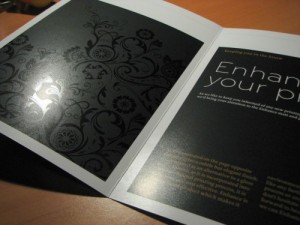Choosing the right color system for printed materials makes all the difference in appearance. Because computers use HTML colors or style sheets, they cannot be used to accurately match colors for printing. Instead, either CMYK or Pantone colors are optimum for bright, accurate colors on printed documents.
CMYK Colors
Using this system, different colors are created by layering cyan, magenta, yellow, and black inks. Also known as process colors, CMYK colors are used in a wide variety of print materials, including magazines and newspapers. The CMYK color model has two primary applications:
Using this system, different colors are created by layering cyan, magenta, yellow, and black inks. Also known as process colors, CMYK colors are used in a wide variety of print materials, including magazines and newspapers. The CMYK color model has two primary applications:
- Full-color photographs and illustrations
- Multi-color graphics that require too many colors to reproduce using Pantone (PMS) shades
CMYK uses a series of dots in the four colors to create images and colors. That method means that a wide variety of colors can be used in a relatively small area. Meanwhile, the main limitation of CMYK colors comes from their inconsistency. The same color may turn out differently, even when the same color appears on multiple pages or even in separate areas on the same page.
Pantone Colors
Often called PMS Match inks or spot colors, Pantone colors use a system similar to that of house paints, where each color corresponds to a number and a swatch sample. Created by mixing 13 base pigments in specified amounts, the PMS model ensures the consistency that is so often lacking with CMYK. Since the color will always turn out the way it looks on the swatch, Pantone colors can be used to match colors, even when it’s impossible to compare samples visually. While PMS inks are not the best choice for full-color photographs, they have several uses:
Often called PMS Match inks or spot colors, Pantone colors use a system similar to that of house paints, where each color corresponds to a number and a swatch sample. Created by mixing 13 base pigments in specified amounts, the PMS model ensures the consistency that is so often lacking with CMYK. Since the color will always turn out the way it looks on the swatch, Pantone colors can be used to match colors, even when it’s impossible to compare samples visually. While PMS inks are not the best choice for full-color photographs, they have several uses:
- Precise color matching for logos and branding
- Covering a large area, where consistency and saturation are important
- Using the same color on multiple pages
- Creating more vibrant hues and precise shades
- Adding special effects like fluorescent, pastel, or metallic colors
Because PMS match inks are so precise, governments around the world have even adopted the Pantone color model to specify flag colors. That quality makes Pantone colors the obvious choice for printing branded materials like letterhead, business forms, and many other promotional materials.
Using CMYK and PMS Colors on the Same Document
Because it is easy to put a logo on such a wide variety of products, it is easy to tailor promotional products to a specific audience. Because these specialty items can be more expensive, careful consideration of the hobbies and interests of the target audience is critical since both CMYK and PMS color models have specific applications, using one system all the time will not always yield the best product. Thus it is sometimes necessary to use both models on the same project:
Because it is easy to put a logo on such a wide variety of products, it is easy to tailor promotional products to a specific audience. Because these specialty items can be more expensive, careful consideration of the hobbies and interests of the target audience is critical since both CMYK and PMS color models have specific applications, using one system all the time will not always yield the best product. Thus it is sometimes necessary to use both models on the same project:
- If full-color photographs will be used along with logo images, it is best to use CMYK for the photographs, and PMS for the logos.
- Graphics that include multiple colors are often too difficult to duplicate using PMS colors, so it may be necessary to use CMYK for more complex graphics.
Using the right color system means printed materials that pop with brilliant, crisp colors. Knowing the difference between CMYK and PMS match inks makes all the difference in accurately adapting computer- and web-based documents into stunning hard copies.















